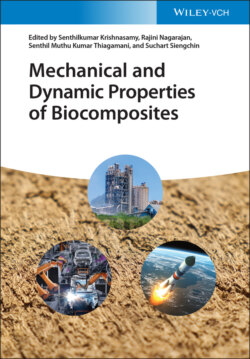Читать книгу Mechanical and Dynamic Properties of Biocomposites - Группа авторов - Страница 18
1.4.1.3 Banana/Kenaf and Banana/Sisal FRP Hybrid Composites
ОглавлениеA good material for reinforcement in diverse polymer composites is the banana fiber. Its extraction is usually from the bark of banana trees [4]. Banana fiber has such advantaged mechanical properties, including good tensile strength and modulus, due to the high content of cellulose and low microfibrillar angle [25]. Kenaf fiber is a promising element of reinforcement in polymer composites, due to its interesting mechanical features such as eco‐friendliness and renewability. Kenaf is usually extracted from bast fiber (kenaf plants) [4]. Sisal, on the other hand, is known to be among the toughest materials for reinforcement. It is also well known for its durability. Sisal FRP composites possess moderate flexural and tensile behaviors and high impact strength, when compared with other composites of natural fiber reinforcements. It has relevant use in some industries, such as agriculture and marine to make twines, ropes, cords, rugs, and bagging, among others [26]. Sisal and kenaf fibers, similar to other natural fibers, have poor interfacial bonding with a polymer matrix, which shows their disadvantage [27].
Table 1.5 Mechanical behaviors of bagasse/jute, bamboo/MFC, and banana/kenaf FRP hybrid composites.
Source: Nguyen et al. [4]. © 2017, Elsevier.
| Hybrid biocomposites | Fiber ratio (by weight or volume) | Flexural modulus (GPa) | Flexural strength (MPa) | Tensile modulus (GPa) | Tensile strength (MPa) | Impact strength (kJ/m2) |
|---|---|---|---|---|---|---|
| Natural fibers | ||||||
| Bagasse/jute | Bagasse fiber bundles (untreated) and jute fiber bundles (treated) | |||||
| 0 : 100 | 0.645 | 31.15 | 0.302 | 11.45 | 6.90 | |
| 20 : 80 | 0.789 | 36.46 | 0.356 | 16.02 | 7.46 | |
| 35 : 65 | 1.101 | 45.32 | 0.420 | 19.45 | 9.53 | |
| 50 : 50 | 1.480 | 55.63 | 0.492 | 23.07 | 10.66 | |
| 65 : 35 | 1.311 | 51.19 | 0.399 | 21.15 | 8.33 | |
| 100 : 0 | 0.502 | 26.78 | 0.227 | 9.87 | 6.67 | |
| Bagasse fiber bundles (treated) and jute fiber bundles (treated) | ||||||
| 20 : 80 | 1.178 | 42.72 | 0.526 | 18.72 | 10.00 | |
| 35 : 65 | 1.484 | 54.57 | 0.635 | 22.57 | 13.33 | |
| 50 : 50 | 1.748 | 65.22 | 0.753 | 26.77 | 15.93 | |
| 65 : 35 | 1.518 | 60.12 | 0.704 | 23.54 | 10.93 | |
| 100 : 0 | 0.632 | 30.78 | 0.286 | 11.20 | 8.66 | |
| Bamboo/MFC | MFC/PLA composites (milled to 5 μm) | |||||
| 1 wt.% of MFC | — | — | 4.61 ± 0.27 | 45.9 ± 4.1 | — | |
| 2 wt.% of MFC | — | — | 3.95 ± 0.14 | 51.7 ± 2.3 | — | |
| Banana/kenaf | 50 : 50, nonwoven hybrid | |||||
| 10% NaOH treatment | — | 57.2 | — | 44 | 13 | |
| 10% SLS treatment | 60.8 | 50 | 16 | |||
| 50 : 50, woven hybrid | ||||||
| 10% NaOH treatment | 62.0 | — | 50 | 18 | ||
| 10% SLS treatment | — | 68.0 | 54 | 21 |
MFC and PLA represent micro‐fibrillated cellulose and poly‐lactic acid, respectively.
Moreover, Thiruchitrambalam et al. [28] conducted a study on woven as well as non‐woven hybrids of banana/kenaf fiber with unsaturated polyester matrix reinforcement. They kept the fiber contents constant at 40% with equal ratio of banana and kenaf FRP composites (50 : 50 ratio) and treated the fibers with either 10% solution of NaOH or 10% of sodium lauryl sulfate (SLS) for 30 minutes. They observed that the SLS‐treated specimen had better improvement with respect to mechanical behavior than the alkali‐treated specimen, showing for both woven and non‐woven cases of the banana/kenaf hybrid composites enhanced impact, flexural, and tensile strengths, as shown in Table 1.5.
Furthermore, Venkateshwaran et al. [29] evaluated the mechanical properties of banana/sisal FRP epoxy matrix hybrid composite and found out that hybridization increased the flexural, tensile, and impact strengths by 4%, 16%, and 35% respectively. They also reported that the 50 : 50 fiber ratio by weight enhanced the mechanical response of the banana/sisal FRP hybrid composite and decreased the uptake of moisture, as presented in Table 1.6.
